
Guard mounting, changing the guard, or the changing of the guard, is a formal ceremony in which sentries performing ceremonial guard duties at important institutions are relieved by a new batch of sentries. The ceremonies are often elaborate and precisely choreographed. They originated with peacetime and battlefield military drills introduced to enhance unit cohesion and effectiveness in the late 17th and early 18th centuries.

A drill team can be one of four different entities:
- A military drill team is a marching unit that performs routines based on military foot or exhibition drills. Military drill teams perform either armed or unarmed.
- A dance drill team creates routines based on precision dance movements rather than military drill. These teams usually do not carry anything, but may use props in field production numbers. They may perform to recorded music, or the live music of an accompanying marching band.
- A team that execute routines carrying either one or multiple flags or pom-poms. This team's movements are also based in dance and may also have a heavy influence of gymnastics as well. These teams also may perform to music, either live or recorded.
- A team that is mounted or advances some type of mobile object. May also include teams of dogs and handlers.

Exhibition drill is a variant of drill that involves complex marching sequences which usually deviate from drill used in the course of ordinary parades. Teams performing exhibition drill are often affiliated with military units, but the scope of exhibition drill is not limited to military drill teams. Exhibition drill is often performed by Armed Forces Precision Drill Teams, the drill teams at service academies and ROTC and JROTC units, and civilian drill teams that perform at parades, drill meets, and half-time shows and other public venues.

Beating Retreat is a military ceremony dating to 17th-century England and was first used to recall nearby patrolling units to their castle.

The Canadian Guards was an infantry regiment of the Canadian Army that served in the same role as the five regiments of foot guards in the British Army. The regiment was formed on 16 October 1953, by Lieutenant-General Guy Simonds, the Chief of the General Staff of the Canadian Army, with the redesignation of four separate battalions:

The Ceremonial Guard is an ad hoc military unit in the Canadian Armed Forces that performs the Changing the Guard ceremony on Parliament Hill and posts sentries at Rideau Hall, with the National War Memorial being sentried by the National Sentry Program (NSP), which is carried out by different regiments and other units in order of precedence throughout the summer until mid-November.

Public duties are performed by military personnel, and usually have a ceremonial or historic significance rather than an overtly operational role.

A military tattoo is a performance of music or display of armed forces in general. The term comes from the early 17th-century Dutch phrase doe den tap toe, a signal sounded by drummers or trumpeters to instruct innkeepers near military garrisons to stop serving beer and for soldiers to return to their barracks and is unrelated to the Tahitian origins of an ink tattoo.

The Music Branch is a personnel branch of the Canadian Armed Forces (CAF). It is primarily composed of band musicians, and also deals with the selection and musical training of its recruits. The branch encompasses all the military bands in service in the Canadian Armed Forces. It is roughly the equivalent to the British Army's Royal Corps of Army Music (CAMUS).
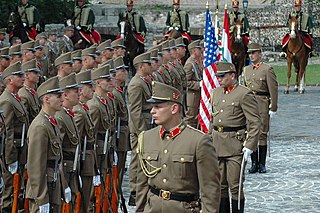
A guard of honour (GB), also honor guard (US), also ceremonial guard, is a group of people, usually military in nature, appointed to receive or guard a head of state or other dignitaries, the fallen in war, or to attend at state ceremonials, especially funerals. In military weddings, especially those of commissioned officers, a guard, composed usually of service members of the same branch, form the sabre arch. In principle, any military unit could act as a guard of honour. However, in some countries certain units are specially designated to serve as a guard of honour, as well as other public duties. Republican Guards, Royal Guards and foot guards frequently have ceremonial duties assigned to them.

The Royal Canadian Artillery Band is one of six Regular Force bands in the Canadian Armed Forces. Located at Canadian Forces Base Edmonton, the RCA Band provides music designed to support Canadian Forces operations, foster morale and esprit de corps, and promote Canada and the Canadian military nationally and abroad. The band operates mainly in western Canada and is de facto the representative band of the Canadian Army in the western provinces. All unit members are professional musicians in addition to being members of the military, which enables the band to adopt a variety of configurations to suit the musical needs of their audiences. Ensembles can range from jazz combos, rock bands, and chamber groups, through stage and show bands to full marching and concert bands.

Canadian military bands are a group of personnel in the Canadian Armed Forces (CAF) that performs musical duties for military functions. Military bands form a part of the Music Branch of the CAF, composed of six full-time professional Regular Force bands, 15 Regular Force voluntary bands, and 53 part-time reserve force bands. Bands of the Music Branch are often badged with the unit or Canadian Forces base insignia that they support.
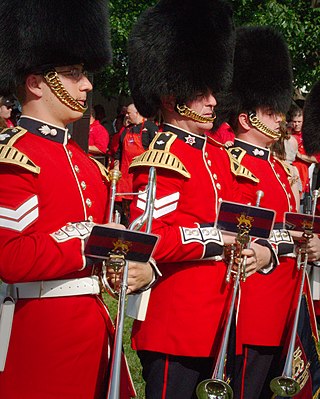
The Governor General's Foot Guards Band is an authorized Canadian Forces 35-piece brass and reed band. It consists of serving members of the CAF who parade on a part-time basis. It serves as the regimental band of the Governor General's Foot Guards (GGFG) and is the most senior band of the Canadian Army Primary Reserve.

The His Majesty the King's Guard 3. Company is a renowned military band and drill unit the Norwegian Armed Forces. It is attached to the Hans Majestet Kongens Garde or The King's Guard, acting as its unit band and drill team. The band and drill unit is based out of Huseby Leir in the capital Oslo where its area of responsibility is. It is a renowned unit that is famous around the world for its participation in international military tattoos. In its activities, it participates in parades and ceremonies for HM Harald V of Norway) and Norwegian members of the House of Glücksburg. It also supports the government and the military, specifically increasing the esprit de corps in army units as well as in the public. The concert season usually lasts from December to March/April while the marching season lasts until September.

The Band of the Ceremonial Guard is an ad hoc military band that is attached to the Canadian Forces Ceremonial Guard in Ottawa. All members of the band are fully trained members of the Canadian Armed Forces (CAF) and consists of personnel principally from the two Foot Guards regiments and has even since 2007 been manned by a pan–Canadian Forces approach that is inclusive to musicians from the Royal Canadian Navy, Canadian Army and Royal Canadian Air Force. The band forms a separate company within the CG and rely on the Headquarters Company for administration and support personnel. In full composition, the band is active from April to August.
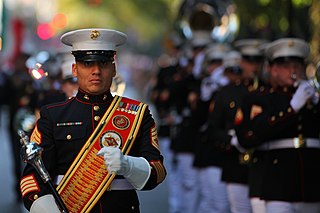
The 2nd Marine Aircraft Wing Band is a United States Marine Corps Air-Ground Task Force regional military band located at Marine Corps Air Station Cherry Point. It performs at basic state functions, civilian ceremonies, and military parades in the region, presenting musical support and entertainment for unit/community events.
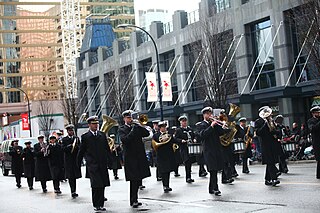
The Naden Band of the Royal Canadian Navy is one of six regular force military bands of the Canadian Forces. The Royal Canadian Navy band is based at CFB Esquimalt in Esquimalt, British Columbia that serves as the official musical unit of the Canadian Forces Maritime Forces Pacific Command (MARPAC).
The Ceremony of the Flags is a Canadian military music event usually held by unit of the Royal Canadian Navy. Queen Elizabeth II, Queen of Canada, had started it in 1965. The display originated from the Sunset Ceremony that was held after the introduction of the Canadian Flag on Parliament Hill in 1965. The ceremony is also derived from the historical Beating Retreat that originated in the United Kingdom and a military tattoo. The first ceremony was held in 1967 in honor of Canada's centennial year celebrations. On Feb 15 1967, local cadet units and the HMCS Carleton Band performed during the first ceremony on Parliament Hill. It was the first ever flag day. For the most part, the Royal Canadian Sea Cadets perform the ceremony annually, with the most prominent one being held at CSTC HMCS Quadra. In years past, naval youth cadet organizations from Hong Kong, Australia, Sweden, South Korea, and the United Kingdom have been participants. The minimum requirement to perform the ceremony is 30 by 60 metres. This ceremony is performed once each year to honor the canadian flags.
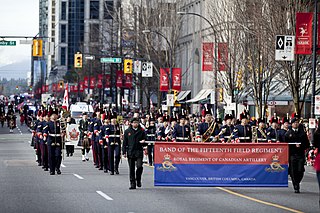
The 15th Field Regiment (RCA) Band is one of five Reserve Force bands in the Royal Regiment of Canadian Artillery, located at Bessborough Armoury in Vancouver, British Columbia, Canada. It is a brass and reed band that is part of the RCA's 15th Field Artillery Regiment. All 45 members of the band are reservists while being trained as soldiers and musicians. The Band plays for a variety of events including military funerals, ceremonies, parades and Mess events. The band maintains a full marching and concert band as well as other musical ensembles that include jazz combos and rock bands.

Navy bands in Canada are part of the Royal Canadian Navy's command structure and overseen by the Music Branch of the Canadian Forces and the Directorate of History and Heritage of the Department of National Defence.


















